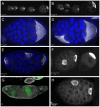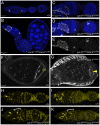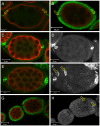Reduced cul-5 activity causes aberrant follicular morphogenesis and germ cell loss in Drosophila oogenesis
- PMID: 20140218
- PMCID: PMC2816211
- DOI: 10.1371/journal.pone.0009048
Reduced cul-5 activity causes aberrant follicular morphogenesis and germ cell loss in Drosophila oogenesis
Abstract
Drosophila oogenesis is especially well suited for studying stem cell biology, cellular differentiation, and morphogenesis. The small modifier protein ubiquitin regulates many cellular pathways. Ubiquitin is conjugated to target proteins by a diverse class of enzymes called ubiquitin E3 ligases. Here we characterize the requirement of Cul-5, a key component of a subgroup of Cullin-RING-type ubiquitin E3 ligases, in Drosophila oogenesis. We find that reduced cul-5 activity causes the formation of aberrant follicles that are characterized by excess germ cells. We show that germ line cells overproliferate in cul-5 mutant females, causing the formation of abnormally large germ line cysts. Also, the follicular epithelium that normally encapsulates single germ line cysts develops aberrantly in cul-5 mutant, leading to defects in cyst formation. We additionally found that Cul-5 is required for germ cell maintenance, as germ cells are depleted in a substantial fraction of cul-5 mutant ovaries. All of these cul-5 phenotypes are strongly enhanced by reduced activity of gustavus (gus), which encodes a substrate receptor of Cul-5-based ubiquitin E3 ligases. Taken together, our results implicate Cul-5/Gus ubiquitin E3 ligases in ovarian tissue morphogenesis, germ cell proliferation and maintenance of the ovarian germ cell population.
Conflict of interest statement
Figures





Similar articles
-
Cullin-5 and cullin-2 play a role in the development of neuromuscular junction and the female germ line of Drosophila.J Genet. 2011 Aug;90(2):239-49. doi: 10.1007/s12041-011-0062-1. J Genet. 2011. PMID: 21869472
-
Regulation of Drosophila vasa in vivo through paralogous cullin-RING E3 ligase specificity receptors.Mol Cell Biol. 2010 Apr;30(7):1769-82. doi: 10.1128/MCB.01100-09. Epub 2010 Feb 1. Mol Cell Biol. 2010. PMID: 20123973 Free PMC article.
-
An E3 ubiquitin ligase, cullin-4 regulates retinal differentiation in Drosophila eye.Genesis. 2020 Nov;58(10-11):e23395. doi: 10.1002/dvg.23395. Epub 2020 Sep 29. Genesis. 2020. PMID: 32990387 Free PMC article.
-
The repertoire of epithelial morphogenesis on display: Progressive elaboration of Drosophila egg structure.Mech Dev. 2017 Dec;148:18-39. doi: 10.1016/j.mod.2017.04.002. Epub 2017 Apr 19. Mech Dev. 2017. PMID: 28433748 Review.
-
Drosophila follicle cells: morphogenesis in an eggshell.Semin Cell Dev Biol. 2008 Jun;19(3):271-82. doi: 10.1016/j.semcdb.2008.01.004. Epub 2008 Jan 20. Semin Cell Dev Biol. 2008. PMID: 18304845 Free PMC article. Review.
Cited by
-
Drosophila SOCS36E negatively regulates JAK/STAT pathway signaling via two separable mechanisms.Mol Biol Cell. 2013 Sep;24(18):3000-9. doi: 10.1091/mbc.E13-05-0275. Epub 2013 Jul 24. Mol Biol Cell. 2013. PMID: 23885117 Free PMC article.
-
Cul2 Is Essential for the Drosophila IMD Signaling-Mediated Antimicrobial Immune Defense.Int J Mol Sci. 2025 Mar 14;26(6):2627. doi: 10.3390/ijms26062627. Int J Mol Sci. 2025. PMID: 40141268 Free PMC article.
-
Role of the insulin/Tor signaling network in starvation-induced programmed cell death in Drosophila oogenesis.Cell Death Differ. 2012 Jun;19(6):1069-79. doi: 10.1038/cdd.2011.200. Epub 2012 Jan 13. Cell Death Differ. 2012. PMID: 22240900 Free PMC article.
-
Oocyte competence is maintained by m6A methyltransferase KIAA1429-mediated RNA metabolism during mouse follicular development.Cell Death Differ. 2020 Aug;27(8):2468-2483. doi: 10.1038/s41418-020-0516-1. Epub 2020 Feb 24. Cell Death Differ. 2020. PMID: 32094512 Free PMC article.
-
Functional complementation of two splicing variants of Gustavus in Neocaridina denticulata sinensis during ovarian maturation.Sci Rep. 2024 Sep 9;14(1):20939. doi: 10.1038/s41598-024-72080-0. Sci Rep. 2024. PMID: 39251721 Free PMC article.
References
-
- Kerscher O, Felberbaum R, Hochstrasser M. Modification of proteins by ubiquitin and ubiquitin-like proteins. Annu Rev Cell Dev Biol. 2006;22:159–180. - PubMed
-
- Deshaies RJ, Joazeiro CA. RING domain E3 ubiquitin ligases. Annu Rev Biochem. 2009;78:399–434. - PubMed
-
- Rotin D, Kumar S. Physiological functions of the HECT family of ubiquitin ligases. Nat Rev Mol Cell Biol. 2009;10:398–409. - PubMed
-
- Petroski MD, Deshaies RJ. Function and regulation of cullin-RING ubiquitin ligases. Nat Rev Mol Cell Biol. 2005;6:9–20. - PubMed
-
- Barry M, Fruh K. Viral modulators of cullin RING ubiquitin ligases: culling the host defense. Sci STKE. 2006: pe21. - PubMed
Publication types
MeSH terms
Substances
Grants and funding
LinkOut - more resources
Full Text Sources
Molecular Biology Databases

